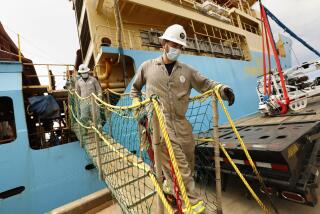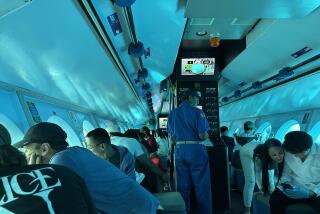DANA POINT : Students to View Sea Bottom Vents
- Share via
So how does an undersea explorer top finding long lost ships like the Titanic and the Bismarck?
How about using underwater robots to help solve the world’s energy problems or discover the origins of life, while simultaneously turning 500,000 schoolchildren into research scientists. With the help of the Dana Point Marine Institute, Bob Ballard intends to do exactly that.
The world-famous adventurer/explorer was in Dana Point on Thursday to discuss the next JASON project, which links cameras that are mounted on submersible boats with television sets in classroom theaters across the United States.
Next March, a million youthful eyes will watch intently as Ballard and other scientists search the ocean floor in the Sea of Cortez for hypothermal vents--a conduit to the immense, churning energy that boils underneath the earth’s crust.
“There’s no limit to what we can do if we harness these forces,” Ballard said after speaking to a group of scientists and educators at the Dana Point Resort last week.
“This is a direct line to the incredible energy that exists beneath the earth’s crust.”
At one time, scientists thought all life fed on energy from the sun.
But organisms found living in complete darkness at the bottom of the ocean by Ballard and a group of marine scientists in 1977 has changed basic theories on how life is created and sustained.
Founded by Ballard three years ago, the JASON project--and its video transmissions--has given students an opportunity to explore the undersea world.
During past voyages, schoolchildren have examined giant coral reefs, gotten face to face with sea lions and giant sea turtles, and inspected sunken ships from the War of 1812.
Last year, the JASON project’s trip to the Galapagos Islands was sponsored locally by the Dana Point Marine Institute, which arranged for students to use a three-screen theater on the campus of UC Irvine in order to participate in the exploration.
By way of images beamed from the waters of Baja California, students this spring will watch scientists working with the rarely seen life forms that grow near hypothermal vents, including giant tube worms, clams and crabs that feed off the bacteria that is created through chemical energy emitted by the hot magma trapped below the earth’s crust.
“We’re taking these kids on a journey of exploration,” Ballard said. “In these rooms, they’re there on the scene, seeing everything the moment I see it” inside a three-man submarine.
About 60 students at selected sites will get a chance to guide JASON, a remote-controlled robot vehicle that patrols the ocean bottom.
“We’re trying to create these sponges that we can pour information into,” Ballard said of his young assistants.
“They’ll process the information later. This is truly hands-on science.”
Students will learn facts about their world that haven’t yet been printed in their schoolbooks.
“We’ve discovered that through these vents . . . the entire volume of the world’s oceans are recirculated about every 6 million years,” Ballard said.
“But that’s not in the schoolbooks yet. Most people don’t know that. But these kids will, and then they’ll go home and teach their parents.”
A native of Southern California, Ballard has plenty of other plans, including producing a science fiction television series that is set in an underwater laboratory in the year 2020 and arranging with the People’s Republic of China to explore its coast for keys to the country’s rich past.
“I tell the kids, ‘I get up at the same time you get up; I go to bed the same time as you. It’s all about how you spend your time,’ ” he said.






